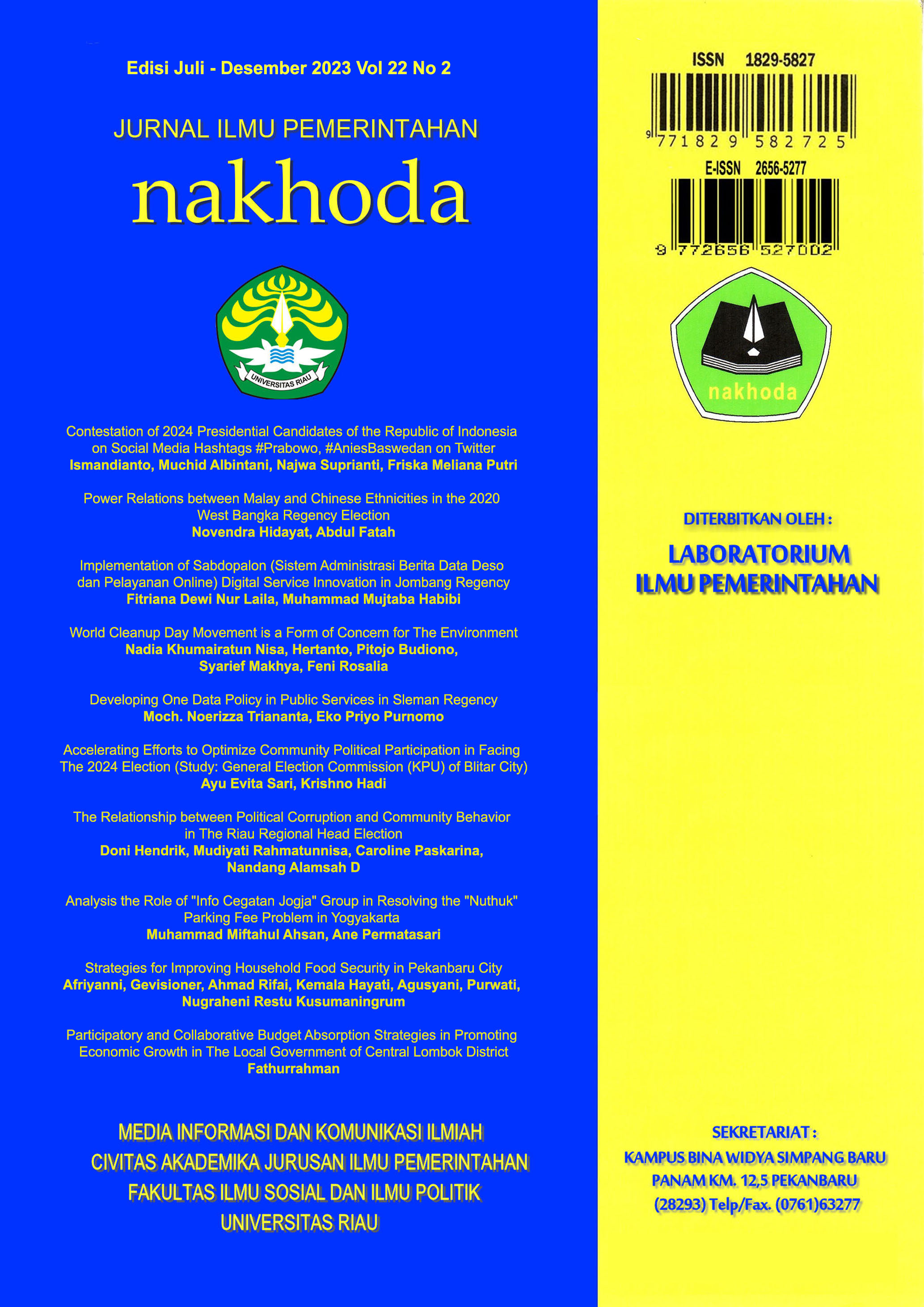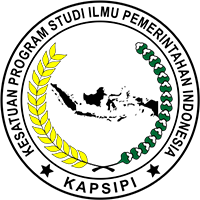Participatory and Collaborative Budget Absorption Strategies in Promoting Economic Growth in The Local Government of Central Lombok District
DOI:
https://doi.org/10.35967/njip.v22i2.629Keywords:
Local Government, Local Finance, Budget Realization, APBDAbstract
This study discusses the constraints in budget utilization and formulates a participatory and collaborative strategy in encouraging economic growth in the Central Lombok Regency Regional Government. This study is intended to analyze the constraints faced so as to formulate strategies using the SOAR method. The type of research used in this study is descriptive qualitative using observation, interview and FGD methods. In formulating the Strategy, this study used SOAR analysis. The study results reveal that there are several obstacles in budget absorption in Central Lombok Regency including: (1) Low technical and managerial skills of local government apparatus in managing the budget; (2) limited adequate facilities and infrastructure to implement development projects; (3) the existence of complex and slow bureaucratic problems in the process of procuring goods and services; (4) lack of coordination and communication between work units within the local government which hinders the effectiveness of budget absorption; (5) lack of public awareness and participation in monitoring the use of local budgets. Meanwhile, to overcome these obstacles, several strategies have been formulated by analyzing them using SOAR. The results of the analysis resulted in several strategies including: Some strategies that have been formulated by looking at strengths and appreciation include: (1) Increasing human resource capacity such as training for PPK, treasurer, finance manager and goods and services manager; (2) Preparing measurable financial planning such as each activity must have a measurable indicator target; (3) Simplifying the process of procuring goods and services. In addition, strategies that have been formulated by looking at opportunities and appreciation include (1) Creating cooperation between actors in the budget absorption process; (2) Strong commitment from the leadership; (3) Creating effective communication in work activities. When looking at the strategies generated by looking at strengths and results, several strategies are obtained, among others: (1) Maximizing the potential of existing human resources so that budget absorption is on time; (2) Ensuring that the budget is used effectively and efficiently. For the next stage, see the strategies resulting from identifying opportunities and results including: (1) Expanding the network of cooperation so that the budget allotted can be maximized properly; (2) Arranging measurable programs and activities so that there is no accumulation of work at the end of the year.
Downloads
References
Agustina, I. D., & Riyanto, F. D. (2023). Determinan Minat Penggunaan E-payment Syariah Dimoderasi Literasi Keuangan Syariah. Jurnal Ilmiah Ekonomi Islam, 9(2), 2059–2070. https://doi.org/10.29040/jiei.v9i2.9010
Anggara, S., & Pilawati, P. (2019). Penyerapan Anggaran Belanja Langsung pada Dinas Kesehatan Kabupaten Bandung. Publica: Jurnal Pemikiran Administrasi Negara, 11(2), 92–106. https://doi.org/ 10.15575/jpan.v11i2.7639
Antari, N. P. G. S., & Sedana, I. B. P. (2018). Pengaruh Pendapatan Asli Daerah dan Belanja Modal Terhadap Kinerja Keuangan Pemerintah Daerah. E-Jurnal Manajemen, 7(2), 1080–1110. https://doi.org/10.24843/EJMUNUD.2018.v7.i02.p19
Erlina, Saputra, A., & Muda, I. (2017). The Analysis of the Influencing Factors of Budget Absorption. International Journal of Economic Research, 14(12), 287–300.
Febrina, R., & Isril. (2016). Analisis Proses Politik Pembahasan dan Penetapan Anggaran Pendapatan dan Belanja Daerah (APBD) Provinsi Riau Tahun Anggaran 2016. Nakhoda: Jurnal Ilmu Pemerintahan, 15(25), 40–52. https://doi.org/10.35967/jipn.v15i25.3853
Halim, A. (2015). Manajemen Keuangan Bisnis: Konsep dan Aplikasinya. Mitra Wacana Media.
Herriyanto, H. (2012). Faktor-Faktor yang Mempengaruhi Keterlambatan Penyerapan Anggaran Belanja pada Satuan Kerja Kementerian/Lembaga di Wilayah Jakarta [Tesis, Universitas Indonesia]. https:// lib.ui.ac.id/detail.jsp?id=20303954
Ishak, K. (2018). Faktor-Faktor yang Mempengaruhi Pengangguran dan Inflikasi Terhadap Indeks Pembangunan di Indonesia. Iqtishaduna: Jurnal Ilmiah Ekonomi Kita, 7(1), 22–38. https://ejournal.stiesyariahbengkalis.ac.id/index.php/iqtishaduna/article/view/121
Kementerian Keuangan. (2023). Laporan Penyerapan Anggaran.
Kusuma Negara, P., Handajani, L., & Effendy, L. (2018). Studi Kasus Fenomena Tingkat Serapan Anggaran pada Satuan Kerja Perangkat Daerah. Jurnal Akuntansi dan Investasi, 19(1), 76–91. https://doi.org/ 10.18196/jai.190193
Miles, M. B., Huberman, A. M., & Saldana, J. (2014). Qualitative Data Analysis: A Methods Sourcebook. SAGE.
Oktaliza, Y., Ahyaruddin, M., & Putri, A. M. (2020). Analisis Faktor-Faktor yang Mempengaruhi Penyerapan Anggaran Belanja di Dinas Pekerjaan Umum dan Penataan Ruang Provinsi Riau. Muhammadiyah Riau Accounting and Business Journal, 1(2), 81–90. https://doi.org/10.37859/MRABJ.V1I2.1918
Ramadhani, R., & Setiawan, M. A. (2019). Pengaruh Regulasi, Politik Anggaran, Perencanaan Anggaran, Sumber Daya Manusia dan Pengadaan Barang/Jasa Terhadap Penyerapan Anggaran Belanja pada OPD Provinsi Sumatera Barat. Jurnal Eksplorasi Akuntansi (JEA), 1(2), 710–726. https://doi.org/10.24036/jea.v1i2.104
Rerung, E. D., Karamoy, H., & Pontoh, W. (2017). Faktor-Faktor yang Mempengaruhi Penyerapan Anggaran Belanja Pemerintah Daerah: Proses Pengadaan Barang/Jasa di Kabupaten Bolaang Mongondow Selatan. Jurnal Riset Akuntansi dan Auditing Goodwill, 8(2), 192–202. https://doi.org/10.35800/jjs.v8i2.17947
Rizkia, T. (2020). Strategi Optimalisasi Penyerapan Anggaran pada Dinas Pekerjaan Umum dan Penataan Ruang Kabupaten Bogor [Master Theses, IPB University]. http://repository.ipb.ac.id/handle/123456789/105596
Robinson, M., & Brumby, J. (2005). Does Performance Budgeting Work? An Analytical Review of the Empirical Literature (2005/210; Working Paper). https://www.imf.org/en/Publications/WP/Issues/2016/12/31/Does-Performance-Budgeting-Work-An-Analytical-Review-of-the-Empirical-Literature-18321
Sinaga, E. J. (2016). Analisis Rendahnya Penyerapan Anggaran Kementerian/Lembaga (K/L) dan Pemerintah Daerah. Jurnal Rechts Vinding: Media Pembinaan Hukum Nasional, 5(2), 261–274. https://doi.org/10.33331/RECHTSVINDING.V5I2.144
Stavros, J. M., Cooperrider, D., & Kelley, D. L. (2003). Strategic Inquiry With Appreciative Intent: Inspiration to SOAR, a New Framework for Strategic Planning. AI Practitioner, 5(4), 10–17.
Stavros, J. M., & Malone, P. (2015). SOAR: Building Strategic Capacity. Dalam Practicing Organization Development (hlm. 285–302). Wiley. https://doi.org/10.1002/9781119176626.ch18
Sugiarti, W. S., Pujangkoro, S. A., & Sembiring, M. T. (2023). Analisis SOAR (Strength, Opportunity, Aspiration & Result) Sebagai Upaya Peningkatan Penjualan Melalui Digital Market. Jurnal IlmiahManajemen dan Kewirausahaan, 2(2), 25–34. https://doi.org/10.55606/jimak.v2i2.1431
Wulandari, W. P., Kuntadi, C., & Karunia, R. L. (2023). Literature Review: Analisis Faktor-Faktor yang Mempengaruhi Penumpukan Penyerapan Anggaran di Akhir Tahun. Jurnal Manajemen, Akuntansi dan Logistik, 1(2), 253–265. https://ciptakind-publisher.com/jumati/index.php/ojs/article/view/37
Yusnita, W. O. A., & Rahim, M. (2015). Analisis Faktor-Faktor yang Mempengaruhi Pelaksanaan Anggaran Berbasis Kinerja (Studi pada Dinas Pekerjaan Umum Kota Kendari). JEP (Jurnal Ekonomi Pembangunan), 5(1), 1–15. https://ojs.uho.ac.id/index.php/JEP/article/view/11822
Downloads
Published
How to Cite
Issue
Section
License
Copyright (c) 2023 Fatur Rahman

This work is licensed under a Creative Commons Attribution-NonCommercial-ShareAlike 4.0 International License.





